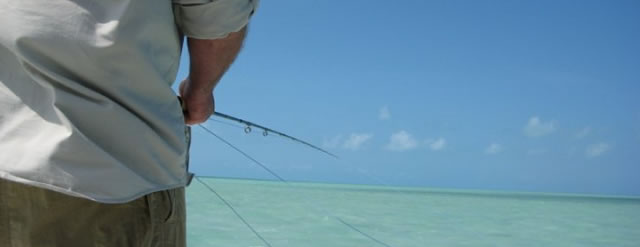Angler’s Elbow (Tennis Elbow)
Instruction By Thomas R. Dempsey, M.D. CCI

Anglers, like all other athletes, are subject to musculoskeletal injuries, and like athletes in certain sports, fishermen have specific aches and pains which are unique to his sport that can rear their head on a fishing trip and make him uncomfortable. One of the most common problems seen in the fly fisherman occurs from using the elbow repetitively to swing a rod and line.
Generically this was referred to as “tennis elbow,” an inflammation of the ligament insertion on the outside of the elbow producing pain on flexion and extension of the elbow, i.e., during the casting stroke, and it is going to be exquisitely tender to the touch.
Anatomically the muscles that extend the wrist originate from the outside of the elbow (the lateral epicondyle). When the junction where the muscles join the bone becomes inflamed, this results in pain. Typically gripping the rod and casting causes discomfort over the outside of the elbow along the bony prominence.
Now, if we could rest the elbow for several weeks or months, it might get well. On the other hand, why not first identify what causes an “angler’s elbow” and try to prevent it? If we are smitten with this demon, how can we treat it and keep fishing?
First, tennis elbow can occur at any time in the beginner or the advanced fisherman. One of the causes of angler’s elbow is an overuse type of situation.
Some of the common causes are:
- —– Going from a lighter to heavier rod
- —– Going from a lighter weight line to a heavier weight line
- —– Prolonged casting
- —– Errors in casting, mechanics
Most cases of tennis elbow can be treated successfully by correcting the cause. Making sure you have good casting mechanics is one way of preventing tennis elbow. This means having nice smooth strokes and not trying to overpower the cast or casting distances that are not within your skill zone. In addition, if you are planning a fishing trip and plan to do a considerable amount of casting, get your elbow in shape before going. There are some simple exercises that we will talk about in the treatment section you can do that will not only help during the acute phase, but also can be preventive.
Using balanced tackle and making sure your rod is lined correctly can prevent one from overworking the elbow during the casting stroke (this includes removing slack before the casting stroke and not trying to cast large amounts of line that you are not used to or comfortable with).
TREATMENT:
Most cases of tennis elbow resolve by themselves with a little rest, but there are some things you can do to help speed up the healing process.
During the acute phase, if you begin having pain after a fishing trip use ice on the elbow for thirty minutes every three to four hours for two or three days or until the pain is gone.
Use a tennis elbow brace or tennis elbow strap. This is a belt-like fixture that fits right below the bump on the outside of the elbow and shifts the pull of the muscles to the tennis elbow brace instead of the bone. This can be worn during the day and during the fishing trip.
Anti-inflammatory medications such as ibuprofen, Naprosyn and aspirin can help with the discomfort, pain and swelling. Once taken, they need to be taken on a regular basis until the pain resolves (usually a week to 10 days).
Steroid injections can be very beneficial in treating the acute phase of the inflammation and can be performed at regular intervals when the pain flares up.
Physical therapy using electrical stimulation and ultrasound can also speed up the healing process.
Once the pain is under control, performing an exercise program two or three times a day can prevent the tennis elbow from recurring.
Surgery – Very few patients who follow the above routine require surgical procedures, but there are operations that can successfully treat chronic epicondylitis.
As mentioned above, exercise programs can be very beneficial in preventing tennis elbow from reoccurring. These exercises should be done when the elbow has cooled down and is comfortable enough to begin exercising.
The elbow exercises are designed to work the muscles that flex and extend the wrist. Simple wrist curls, regular and reversed, done in three of eight repetitions two or three times a day are helpful. Another exercise that I found to be very beneficial is gripping a tennis racquet or baseball bat and rotating it clockwise and counter clockwise with the elbow extended out in front of one back and forth repetitiously. This seems to stretch the muscles that insert into the elbow and prevent the contracture that results from the healing process of damaged muscles being stretched out and pulled apart the next time you cast. Keeping these muscles and tendons and the forearm muscles strong is the key to preventing chronic epicondylitis.
Most cases of epicondylitis are allowed to progress too far before they are treated so I would encourage anyone who has the signs and symptoms not to ignore them but to get immediate treatment which can prevent a fishing trip from being ruined.
Thomas R. Dempsey, certified casting instructor Mobile, Alabama.
